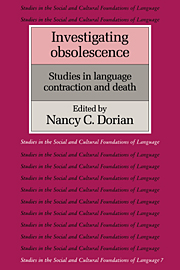Book contents
- Frontmatter
- Contents
- List of maps
- List of contributors
- Preface
- Map
- Dedication
- Introduction
- I Focus on context
- II Focus on structure
- 11 Problems in obsolescence research: The Gros Ventres of Montana
- 12 The structural consequences of language death
- 13 On signs of health and death
- 14 Case usage among the Pennsylvania German sectarians and nonsectarians
- 15 Estonian among immigrants in Sweden
- 16 The incipient obsolescence of polysynthesis: Cayuga in Ontario and Oklahoma
- 17 Urban and non-urban Egyptian Nubian: Is there a reduction in language skill?
- 18 Some lexical and morphological changes in Warlpiri
- 19 Language contraction and linguistic change: The case of Welland French
- 20 Lexical innovation and loss: The use and value of restricted Hungarian
- III Invited commentaries
- Bibliography
- Index of languages
- General index
20 - Lexical innovation and loss: The use and value of restricted Hungarian
Published online by Cambridge University Press: 08 January 2010
- Frontmatter
- Contents
- List of maps
- List of contributors
- Preface
- Map
- Dedication
- Introduction
- I Focus on context
- II Focus on structure
- 11 Problems in obsolescence research: The Gros Ventres of Montana
- 12 The structural consequences of language death
- 13 On signs of health and death
- 14 Case usage among the Pennsylvania German sectarians and nonsectarians
- 15 Estonian among immigrants in Sweden
- 16 The incipient obsolescence of polysynthesis: Cayuga in Ontario and Oklahoma
- 17 Urban and non-urban Egyptian Nubian: Is there a reduction in language skill?
- 18 Some lexical and morphological changes in Warlpiri
- 19 Language contraction and linguistic change: The case of Welland French
- 20 Lexical innovation and loss: The use and value of restricted Hungarian
- III Invited commentaries
- Bibliography
- Index of languages
- General index
Summary
Introduction
This chapter considers the Hungarian lexicon of Hungarian–German bilingual speakers in an Austrian community that has been shifting away from Hungarian for about forty years. I will use evidence about the formation and use of verbs in order to address the following questions: Which word-formation devices or patterns are retained and which are lost by those speakers who use Hungarian only in a narrow range of contexts? What accounts for the fact that, despite diminishing social function for the language, narrow-users are in one sense more innovative than broad-users in several kinds of word formation?
Among documented cases of community-wide language loss there is considerable variation in the rapidity of loss and in the extent of discontinuity between generations or social groups of speakers. When, as in the present case, the shift takes more than one generation and occurs through a restriction in the social functions of the obsolescent language, it raises theoretical questions about the relationship of language use to linguistic structure (Hymes 1974). The explanation for documented linguistic differences between those who use a language in a wide range of contexts and those who do not has most often been sought in the early and continuing effects of those very differences in range of use. According to this hypothesis, the decreasing use of the obsolescent language by adults, and its increasing functional specialization, lead to the incomplete acquisition of the language by children. We can thus understand the frequent loss of linguistic structures that are not available at all for input to children.
- Type
- Chapter
- Information
- Investigating ObsolescenceStudies in Language Contraction and Death, pp. 313 - 332Publisher: Cambridge University PressPrint publication year: 1989
- 23
- Cited by



